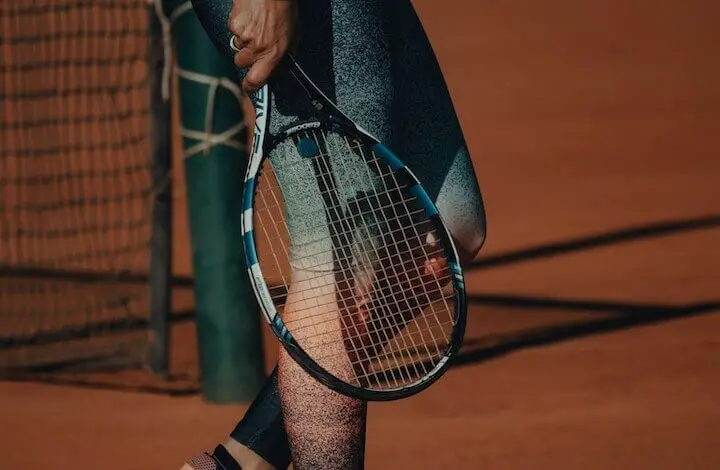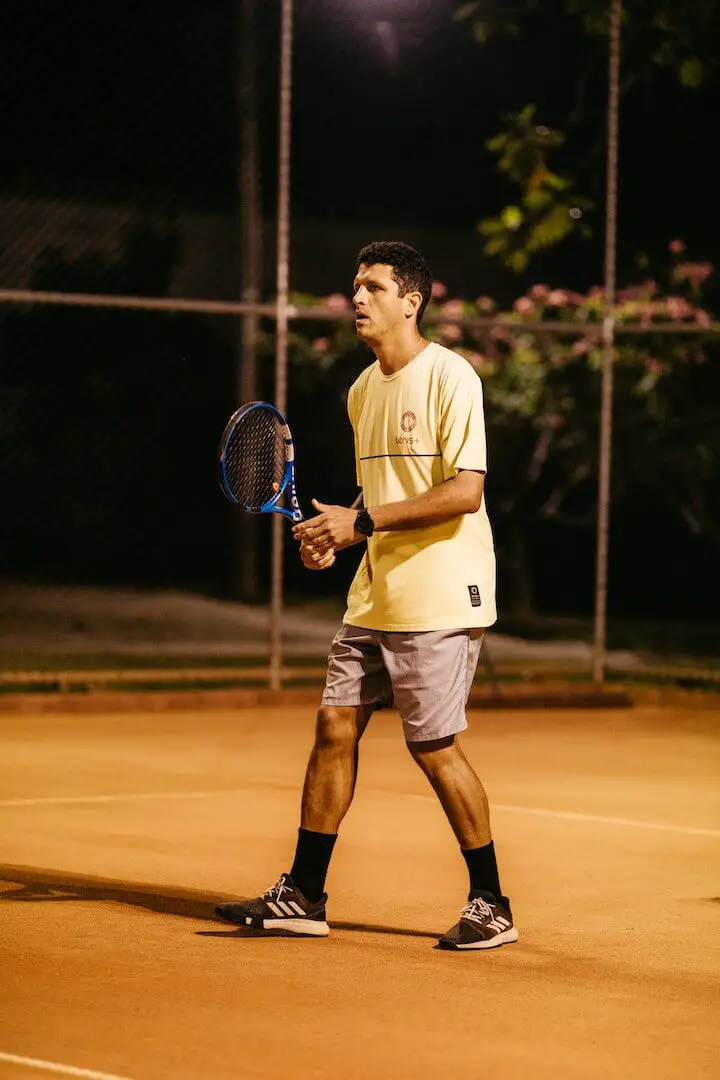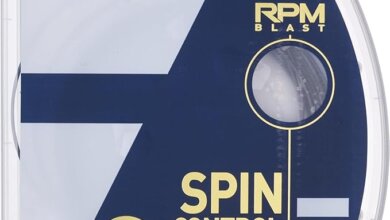
We're an affiliate
We hope you love the products we recommend! Just so you know, we may collect a share of sales or other compensation from the links on this page. Thank you if you use our links, we really appreciate it!
Let’s settle this. You’ve probably seen those little rubber pieces stuck between the strings of a tennis racket and wondered—what’s the point? Someone tells you they help with arm pain. Someone else says they’re just for sound. And now you’re stuck in the middle of the tennis dampeners vs no dampeners debate, wondering if you should even care.
Here’s the thing: This isn’t about doing what the pros do. It’s not about copying your tennis buddy who swears by a certain setup. It’s about how you feel on the court. What brings you clarity. What gets in your way.
I’ve gone back and forth with this over the years, and I’ll tell you everything you need to know. The good, the bad, and the stuff no one explains properly. So whether you’ve never used a dampener or you’ve been using one without knowing why—this is for you.
Table of Contents
Key Takeaways
- Tennis dampeners don’t affect performance—they change the feel and sound.
- Some players find them mentally calming. Others prefer raw feedback.
- There’s no right answer. Even the pros are split.
- Try both and listen to your body. Trust your experience.
- What matters most is that you feel good on the court.
What Exactly Is a Tennis Dampener?
Let’s keep it simple.
A tennis dampener—also called a vibration dampener—is a small accessory made of rubber or silicone. It gets placed between the main strings of your racket, usually near the bottom, just above the throat.
What’s it supposed to do?
Well, here’s where things get fuzzy. Many people assume it helps reduce the vibration that travels through your arm. But that’s not really true. It doesn’t stop the kind of vibration that causes injury.
What it does do is reduce the high-pitched vibration you feel in the string bed. You know that “ping” sound after a shot? That’s what a dampener softens.
So in a way, it’s more about sound and feel than actual performance.
Here’s what it’s not:
- It’s not going to protect you from tennis elbow.
- It doesn’t make your racket magically more comfortable.
- It doesn’t improve your spin, power, or control.
But for something so small, it can still change the way you experience your shots. And sometimes, that’s everything.

What Happens When You Use a Dampener?
This is where things start to get personal. Because what I feel might not be what you feel. But I’ll try to paint the picture.
The Sound Changes
When you hit the ball, it no longer sounds like a metallic “ping.” Instead, it becomes a lower, softer “thud.” It’s less jarring. Less sharp. And for some people, that subtle change makes a world of difference.
It’s kind of like muting the sound in your car. Same drive. Same road. But quieter.
The Feel Becomes Softer—Sort Of
Notice I said “sort of.” Because again, the dampener only absorbs vibration in the strings. That’s the initial buzz. You might still feel the impact through your frame and handle, especially on mishits.
But for some reason, that little tweak in string vibration can trick your brain into thinking the whole hit feels cleaner.
Mental Calm
I didn’t expect this when I first used a dampener, but it helped quiet my mind. When you take away the harsh ping, every shot feels more focused. More centered. Less noise means fewer distractions.
Now, that’s not a universal experience. But if you’re someone who gets overwhelmed by sound or overthinks during points, this matters.
What Happens When You Don’t Use One?
Alright, now let’s look at the other side of the tennis dampeners vs no dampeners argument. What’s it like going without one?
A Lot More “Ping”
You’ll notice it instantly. Without a dampener, your racket sounds sharp and metallic, especially on off-center hits. Some players actually love this. They say it makes the racket feel “alive.”
But others? They find it annoying, or even mentally draining.
More Connection
This part is a bit hard to explain. Without a dampener, you feel more of what the strings are doing. It’s not that it’s more powerful—it’s just more raw. There’s a kind of feedback loop between your hand and the strings, and some players feel like they’re more connected to their shots this way.
If you’re the type who likes that gritty, responsive feel, going dampener-free might make sense.
Distractions, Maybe
Personally, there were times when the extra sound and buzz made me second-guess my shots. I’d think something went wrong when it didn’t. So instead of staying in rhythm, I’d overanalyze.
But again, this comes down to personal wiring.
Tennis Dampeners vs No Dampeners: Do the Pros Care?
This is where people get hung up. They say, “Well, Federer uses one!” or “Nadal doesn’t!” like it settles the debate.
But guess what? The pros are just like us when it comes to this. Some use them. Some don’t. It’s not based on science. It’s preference.
Here’s a quick look:
- Novak Djokovic uses a dampener.
- Rafael Nadal does not.
- Roger Federer used one, but it was often just a rubber band.
- Dominic Thiem doesn’t use one.
So what does that tell you? Nothing, really—except that even at the highest level, this comes down to feel, not facts.
If the top players in the world can’t agree, then there’s clearly no “correct” way. That’s comforting, isn’t it?
Should You Use a Tennis Dampener?
This is where things get interesting. And simple.
Ask Yourself:
- Does the sound of the strings bother me?
- Do I feel distracted or disconnected on contact?
- Do I want something softer in feel, even if it’s mostly psychological?
If you answered yes to any of those, then try a dampener.
On the Other Hand:
- Do you enjoy the crisp, pingy feedback?
- Do you feel more control or confidence without one?
- Are you not bothered at all by sound?
Then stick with what you’ve got. There’s nothing wrong with going without.
The most important thing? Don’t use one just because someone told you to. Try both. Switch back and forth for a few sessions. You’ll feel the difference immediately.
Trust that feeling.
Check out: Ultimate String Tension Guide for Beginners: Find Your Perfect Setup
Tennis Dampeners vs No Dampeners: My Personal Take
Alright, here’s what happened with me.
I started using a dampener because a friend gave me one. I didn’t really notice a big difference at first, but I liked the way it looked. Later on, I started paying attention to the sound and realized I liked how quiet the racket felt.
But after a while, I took it off just to see. Suddenly, every shot felt louder, more alive. It was weird. Not bad, just different.
So I went back to the dampener. Then off again. I did this back and forth dance for months. Eventually, I realized I play my best when things feel calm. The softer sound helps me focus. So now? I keep it on.
But that’s just me. You might land somewhere else. And that’s the point.
There’s no right way—only your way.

Conclusion
If you’ve made it this far, you already know this isn’t really about rubber. It’s about you—your comfort, your rhythm, your clarity.
The tennis dampeners vs no dampeners debate can get loud. People throw around opinions like they’re rules. But here’s the truth: none of that matters unless it feels right for you.
Try it both ways. Stay curious. And remember, your best tennis comes when you’re connected—to your shots, your senses, and your instincts.
Let that be your guide.
Frequently Asked Questions
Do dampeners reduce the risk of tennis elbow?
No, they don’t. Tennis dampeners only reduce the string’s vibration, not the harmful shock that travels through the frame.
Why do some pros not use dampeners?
Personal preference. Some like the natural feel and sound of the racket without one. Others just don’t notice enough of a difference.
Can I use any object as a dampener?
You can. A lot of players use a simple rubber band. It works the same as store-bought dampeners and costs almost nothing.
Will using a dampener improve my game?
Not directly. But if it helps you focus or makes the racket feel more comfortable, then yes—it might help your game indirectly.




